How would you like that cooked?
A few years ago, my father-in-law came over for a barbecue. He’s a real “foodie” — he wants his hot food hot, his cold food cold, and he likes his meat cooked just right.
I fixed burgers with all the trimmings, my home-made coleslaw and dressing, and red-skin potato salad with homemade dressing. Baked beans with onions and brown sugar, of course, was also on the menu, as were roasted vegetables. It was to be a feast! The centerpiece of the meal, naturally, were the burgers. No run-of-the-mill beef for him, though. I decided to prepare my best, yummiest, homemade plant-based burger. Only the best for my father-in-law.
Of course, he did not know the burgers were homemade “veggie burgers” until the third or fourth bite when all of it just fell apart and dribbled down his shirt.
He politely asked, “What am I eating?”
“Cultured meat,” I answered.
He looked at me with a smirk, and asked again, “What is this stuff?”
This time I replied, “Cultivated meat.” (Whatever that means.)
By now he was aggravated and asked, “Is this real meat or not?”
I finally confessed. “No. It’s plants made to look like beef. Don’t you like it?”
He politely finished his burger and said it wasn’t too bad . . . “as long as it could be drowned in ketchup, mustard, and relish!”
Well, I tried. Over the years I’ve cooked countless veggie burgers. Some have looked unattractively nutritious, full of beans, seeds, and nuts. Others were mushy and not very burger-esque. As a rule, my veggie burgers leave much to be desired, especially for real-meat eaters like my father-in-law.
Mimicking meat
A whole new batch of non-meat meats are now all the rage. Fake meat is becoming mainstream. It’s a multi-billion-dollar industry invading our kitchens, drive-throughs, and restaurants. These new meatless products are thought of as wholesome and vegan. They are marketed as nearly indistinguishable from real meat and fall into two categories: cell-based protein and plant-based protein.
Cell-based protein meat
In cell-based protein, an animal starter cell, usually a muscle cell, is extracted and grown in a lab culture. (Yes, you really can do this.) In the six weeks it takes to grow a chicken for slaughter, the cell culture-based process produces the same amount of meat-like protein, minus the bones, feathers, etc. These protein-cultured “meats” have many names like slaughter-free meat, in-vitro meat, vat-grown meat, lab-grown meat, cell-based meat, clean meat, cultivated meat, and synthetic meat.
The world’s first lab-grown burger was cooked and eaten in August 2013 at a news conference in London. Scientists at the Netherlands’ Maastricht University had taken about 20,000 thin strands of starter-muscle tissue from a cow and grew them (in the lab) into strips of muscle. They combined those strips with other substances to form what looks like a real-meat burger.
Some companies developing lab-grown meat:- Just Meat
- Memphis Meats
- Finless Foods
- SuperMeat (from Israel), and
- Mosa Meat (from the Netherlands)
The initial stage of growing cultured meat is to collect cells that have a rapid cell-reproduction rate. Such starter cells include embryonic stem cells, adult stem cells, myosatellite cells, or myoblasts – embryonic progenitor cells that differentiate and give rise to muscle cells (see image.) Myoblasts proliferate at an acceptable rate and sufficiently differentiate from other cell types. The starter myoblast is then treated by applying nutrients and appropriate chemicals to promote rapid tissue growth.
Theoretically, once this process starts, one could continue growing meat cells indefinitely. It has been claimed that in just two months, cultured meat production could deliver up to 50,000 tons of meat from 10 pork starter-muscle cells. Growers need chemicals to preserve and protect the growing cells from bacteria, yeast, and other fungi.
Chemicals used in cultured meat production
- Sodium benzoate (food preservative widely used in salad dressings)
- Collagen powder (protein-building block of bones, skin, muscles, tendons, and ligaments)
- Xanthan gum (complex sugar used as a thickening agent)
- Mannitol (sugar alcohol used as a sweetener)
- Cochineal (extracted from female cochineal insects to produce dye and coloring agents)
Large-scale production of cultured meat may or may not require artificial growth hormones. At the present time, engineered meat is not commercially available, but it’s coming.
Plant-based protein meat
For plant-based protein products, protein extracts and isolates from a plant are combined with other “stuff” to make the non-meat protein as “meaty” as possible.
Currently, the two top contenders in the plant-based meatless meat market are Beyond Meat, which markets the Beyond Burger (featured in Carl’s Jr., Subway, and now McDonald’s), Beyond Beef (plant-based ground) and Beyond Sausage; and Impossible Foods, which markets the Impossible Burger sold in grocery stores and also at Burger King, Red Robin, White Castle, Umami Burgers, A&W, and Qdoba.
Battle of the burgers
The top five Impossible Burger’s ingredients include water, soy protein concentrate, coconut oil, sunflower oil, and natural flavors. But the secret sauce that makes the Impossible Burger taste so much like real burger meat is heme, found in nodules attached to roots of nitrogen-fixing plants, in this case, soy. This heme is similar to myoglobin and hemoglobin, which makes human blood red. The plant-based heme, called leghemoglobin, inserts into genetically engineered yeast. When the yeast goes through fermentation it stimulates production of more heme.
The other “stuff” in the Impossible Burger includes potato protein, methylcellulose, cultured dextrose, food starch, salt, soy-protein isolate, mixed tocopherols (vitamin E), zinc gluconate, thiamine hydrochloride (vitamin B1), sodium ascorbate (vitamin C), niacin, pyridoxine hydrochloride (vitamin B6), riboflavin (vitamin B2), and vitamin B12.
Overall, the Impossible Burger is kosher and halal-certified, but not organic. A 4 oz. patty packs 240 calories, 370mg of sodium, 19g of protein, zero cholesterol, 14g of fat (including 8g of saturated fat), and 370mg of added salt – 16 percent of the daily recommended amount. Also, the Impossible Burger contains less than 1g of added sugar and 3g of fiber per serving, largely in the form of methylcellulose, a plant-based bulk-forming binder.
The top four components of the Beyond Burger include water, pea protein isolate, expeller-pressed canola oil, and refined coconut oil. It also includes two percent or less of cellulose from bamboo, methylcellulose, potato starch, natural flavor, maltodextrin, yeast extract, salt, sunflower oil, vegetable glycerin, dried yeast, gum arabic, citrus extract (to protect quality), ascorbic acid (to maintain color), beet juice extract (for color), acetic acid, succinic acid, modified food starch, and annatto (for color).
Nutrition facts and ingredients
Impossible Burger (4 oz., 113g)
Source: impossiblefoods.com
- Calories 240
- Total Fat 14g
- Saturated Fat 8g
- Cholesterol 0
- Sodium 370mg
- Total carbohydrates 9g
- Dietary Fiber 3g
- Total sugars <1g
- Protein 19g
- Calcium 170mg (15% DV)
- Potassium 610mg (15% DV)
- Iron 4.2mg (25% DV)
Ingredients: water, soy protein concentrate, coconut oil, sunflower oil, natural flavors. Contains 2% or less of: potato protein, methylcellulose, yeast extract, cultured dextrose, food starch modified, soy leghemoglobin, salt, soy protein isolate, mixed tocopherols (vitamin e), zinc gluconate, thiamine hydrochloride (vitamin b1), sodium ascorbate (vitamin c), niacin, pyridoxine hydrochloride (vitamin b6), riboflavin (vitamin b2), and vitamin b12.
Beyond Burger (4 oz., 113g)
Source: beyondmeat.com
- Calories 250
- Total Fat 18g
- Saturated Fat 6g
- Cholesterol 0
- Sodium 390mg
- Total carbohydrates 3g
- Dietary Fiber 2g
- Total sugars 0
- Protein 20g
- Calcium 80mg (6% DV)
- Potassium 300mg (6% DV)
- Iron 4.5mg (25% DV)
Ingredients: Water, pea protein isolate, expeller-pressed canola oil, refined coconut oil. Contains 2% or less of the following: cellulose from bamboo, methylcellulose, potato starch, natural flavor, maltodextrin, yeast extract, salt, sunflower oil, vegetable glycerin, dried yeast, gum arabic, citrus extract (to protect quality), ascorbic acid (to maintain color), beet juice extract (for color), acetic acid, succinic acid, modified food starch, annatto (for color), water, fats (triglycerides, trans-fatty acids), proteins (15 different amino acids; essential and non-essential), carbohydrates (glycogen), natural occurring flavorings, naturally occurring water and water insoluble vitamins, and naturally occurring minerals.
Raw Beef (4 oz., 113g; grass-fed; 80% lean)
Source: nutritionvalue.org.
- Calories 287
- Total Fat 23g
- Saturated Fat 8.6g
- Cholesterol 80mg
- Sodium 75mg
- Total carbohydrates 0
- Dietary Fiber 0
- Total sugars 0
- Protein 19g
- Calcium 20.3mg (2% DV)
- Potassium 305mg (6% DV)
- Iron 2.19 mg (12% DV)
Ingredients: Water, fats (triglycerides, trans-fatty acids), proteins (15 different amino acids; essential and non-essential), carbohydrates (glycogen), naturally occurring flavorings, naturally occurring water, and water-insoluble vitamins, and naturally occurring minerals.
Other considerations
Plant-based meat sounds nutritious. Individually, the ingredients pose no harm. But we should not assume plant-based meat is harmless before we have results of more extensive and long-term research. I am most interested to see how different ingredients in combination interact with and affect the gut microbe (see my Health Yourself column “Gut Check”). I also would like to see more research on health issues associated with genetically modified foods (see my Health Yourself column “Do we really need or want genetically modified foods?”).
Artificial meat producers want to redefine “meat” as nothing more than a proprietary mix of chemicals – proteins (amino acids), flavors, and colorings – creating replicas of animal meat by way of creative molecular bioengineering. Indeed, these companies have succeeded in reproducing a meat-like burger that’s not real meat. But while they’ve skillfully replicated the taste, sight, and even smell of real meat, there’s still something different.
Real animal meat is more than just chemistry. Like all real food, it’s the totality of the whole food that’s important, not any single ingredient. As we’ve seen with other real whole foods, altering its composition by isolating, reducing, or adding ingredients fundamentally changes how that food behaves and contributes to the human body and overall health.
My advice: Eat real food whenever possible!
References
- “Key ingredient in ‘Impossible Burger’ approved by FDA.” CNBC. 2018-07-24.
- Ahmad, R.S., et al. “Nutritional composition of meat.” 2018, IntechOpen.
- Eshel, G., et al. “Environmentally optimal, nutritionally aware beef replacement plant-based diets.” Environ Sci Technol. 2016; 50:8164.
- Fellet, M. “A fresh take on fake meat.” 2015, ACS Central Science; 1 (7):347.
- Fresán, U., Sabaté J. “Vegetarian diets: Planetary health and its alignment with human health.” 2019, Adv Nutr; 10 (Supplement 4):S380-S388.
- Goldstein, B. “Potential to curb the environmental burdens of American beef consumption using a novel plant-based beef substitute.” 2017, PLoS One; 12(12): e0189029.
- Katz, D.L. “Plant-based diets for reversing disease and saving the planet: Past, present, and future.” 2019, Adv Nutr; 10 (Supplement 4):S304-S307
- Laster, J., Frame, L.A. “Beyond the calories: Is the problem in the processing?” 2019, Curr Treat Options Gastroenterol;Nov 30. doi: 10.1007/s11938-019-00246-1. [Epub ahead of print] Review.
- Pimentel, M. “Sustainability of meat-based and plant-based diets and the environment.” 2003, Am J Clin Nutr; 78 (suppl):660.
- Proença, V., Teixeira, CMGL. “Beyond meat: Ecological functions of livestock.” 2019, Science; 366 (6468):962.
- Simsa, R. et al. “Extracellular heme proteins influence bovine myosatellite cell proliferation and the color of cell-based meat.” 2019 Foods. Oct 21; 8(10).
- Springmann, M., et al. “Options for keeping the food system within environmental limits.” 2018 Nature; 562.

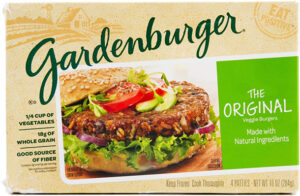
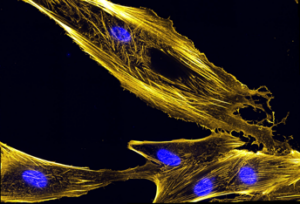
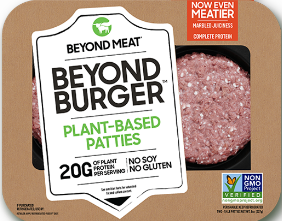
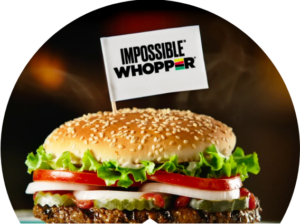
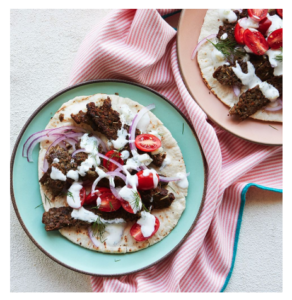

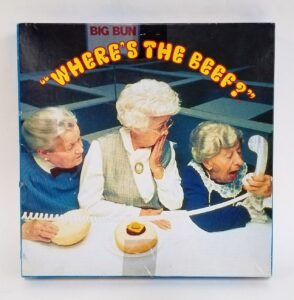
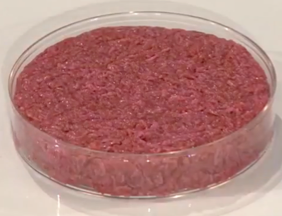


Donna Ponte - 1972
Wish you’d have included ingredients and stats for a beans seeds and nuts vegie burger for comparison.
I’m a new vegan no-oil and love real vegie burgers. I do not like meatie looking or tasting subsitutes.
Reply
Nancy Downie - 1990
My husband and I have been vegan for almost 8 years. For health, environmental and animal welfare reasons, I think people should be eating less or no “real meat”. But I, like the author, am skeptical of many of the plant-based “meat” products that are becoming increasingly sophisticated and available. Many taste amazing, and I’m glad they are being offered in restaurants as meat alternatives as it can be hard for vegans to eat out. But for the day-to-day, I will stick with “veggie burgers” made with beans and nuts and other real food and with time-tested meat substitutes such as tofu and tempeh.
Reply
Barbara Bradley
I’m sorry. These “fake” burgers don’t sound appealing in any way to me! They weren’t appealing before I read this. Now they are even less so!! Great article though.
Reply
BONNIE KREY - N/A
Does anybody remember the movie “Soylent Green?”
Reply
V Coleman
Yes! Thank you for publishing what really goes into meatless burgers…whole foods for a whole life.
Reply
Lee Gorman - 79, 83
I tried one impossible burger…it was “ok,” but I far prefer a spicy black bean or other veggie burger. Maybe because I’ve gone meat-free for 30 years I’m just not attracted to something that is meat-like. The long list of chemicals makes it less attractive.
Reply